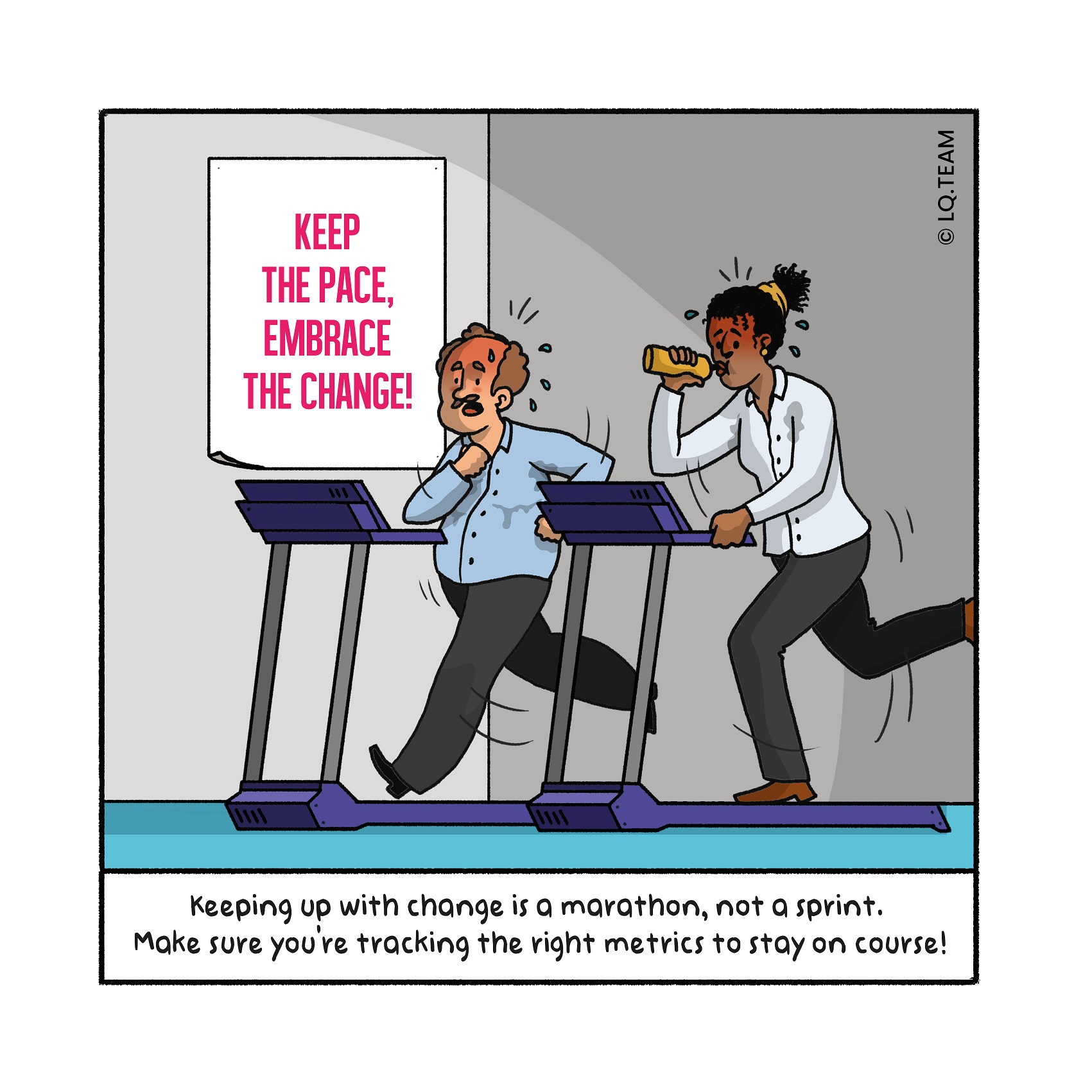
Nut to crack: How do you measure the progress of an organisational change?
How well is the change going? Is there enough progress? Is the pace too fast or too slow? Will the desired impact be achieved? And if not, is this visible to the right people who need to act on it? In short, how do you measure and how do you report?
Nutcracker: Measure business and change management progress
Measure two topics to visualise the progress of an organisational change:
- Progress on the realisation of set business objectives
- Progress in change management
Collate these two elements into a dashboard you regularly report on.
1. The realisation of set business objectives
Go back to your case for change, your change story and the indicators of success. What was the intended purpose of the organisational change? What did you want to improve? Was it about revenue growth in a new product cat- egory? Or about making a departmental process more efficient? Usually, the business-related success indicators are about one or more of the following:
- Product- & service-related indicators,
- Operational and internal indicators,
- Customer-related indicators,
- Financial indicators,
- Market-related indicators,
- Employee-related indicators,
- Leadership-related indicators,
- Sustainability-related
You determine these indicators of success at the start. If you have not done so, do it with critical stakeholders so that you can monitor and report on progress.
2. Progress in change management
To measure progress in change management, you look at progress on three levels:
- Is the organisation ready for change?
- Is the programme ready for change?
- Is the individual ready for change?
You get an understanding of the progress in change management by answer- ing these three questions systematically.
The support tool contains more information about measuring change read- iness at each level, and the practical example describes how to use these instruments effectively in practice.
Support tool: Three instruments to measure progress in change management
To measure progress in change management, I prefer to work with the en- ergise for success instruments of lq, the business transformation consulting firm I work on as a managing partner.17
As introduced in Challenge 15, you can use the Six Batteries of Change Scan to measure whether the organisation is ready for change. With this scan, you systematically map out where the organisation is gaining or draining energy. Typically, you use this scan once a year and have it completed by the top and middle management. The batteries turn red, orange or green depending on how much they are charged. The greener they are, the healthier the soil for change. The redder they are, the more work there is to create an organisa- tional environment where change can land successfully.
Like on the organisation level, you can measure if the programme is ready for change. To do so, you can use the change programme scan. Using this scan, you can map out in a structured manner where you need to energise your programme for success and crack some nuts. The scan is completed by the change team and the stakeholders involved in the change programme, and is typically done once every trimester. The next figure shows an example of the outcome of this scan. The five dimensions are coloured red, orange or green, depending on the number of energy gainers and drainers in that domain. The greener they are, the higher the chance of a successful implementation. The redder they are, the more work there is to do to remove obstructions on the programme level. As you can see, the five core questions in this book, are central to this scan.
Finally, you need to assess whether individuals are ready for change. The figure below shows what the commitment stages look like. As you can see, you can win or lose people on every stage of the journey.
To measure individual commitment, you can use the individual commitment scan. The individuals impacted by change complete the scan. The commit- ment levels are coloured red, orange or green depending on the commitment level of individuals. The greener the scan, the higher the adoption level, and the greater the chance of successful implementation; the redder the scan, the more work there is to do to support people on their change journey.
When you bring progress on the realisation of set business objectives and in change management together, you best visualise the outcomes on one dashboard.
Please have a look at www.lq.team/nutcracker to see an example of a dash- board.
Real-life example: Measuring progress in change management
A business leader leads a comprehensive transformation programme to restore profit ability. He has a team of eight transformation leaders who work with him. Because this programme is so extensive, it is difficult for employees and managers to keep seeing the bigger picture. The leader therefore wants to use a periodic progress measurement as a means of communication to make it clear to every employee and manager what this transformation is about and where it stands now.
He looks at quantitative parameters like profitability and costtoserve metrics, and at specific employee engagement measures which connect directly to the transformation agenda. He measures progress in change management at the organisational level using the six battery scans. In addition, he measures progress at the level of the two most important change programmes, boost (Innovation) and force (supply chain), using the programme scan, and he measures the commitment levels of individuals.
Every quarter, he publishes a dashboard with these results and makes it transparent to all change leaders and enablers involved. With the core team, he discusses these results in a quarterly meeting called the Breathing in & Breathing out meeting. During this meeting, his team reflects on best practices to be proud of and unresolved change dilemmas that are emerging. Next, the team comes up with those interventions needed now and adjusts their roadmap accordingly. These meetings turn into a ritual. A feeling of togetherness and connection builds so they can start the next quarter full of energy.
Tip for change leader
The more people you give access to the data about the progress being made, the more you enable people to act as change owners.
Tip for change enabler
To get the most out of the individual commitment measurement, take the time it needs to specify the pockets of change per employee group, meaning the changes in ways of working you would like to see for that group. If you do not specify those pockets of change and tie these to the survey questions, the survey becomes too generic and will not tell you the honest story about the real adaptation grade.
Kernel: Measure on two axes
You measure change progress over two axes: business performance and change management. Measure change readiness at the organisation, pro- gramme and individual levels, and measure it periodically. Formulate key ac- tions and update your change roadmap accordingly to ensure the change truly sticks.

